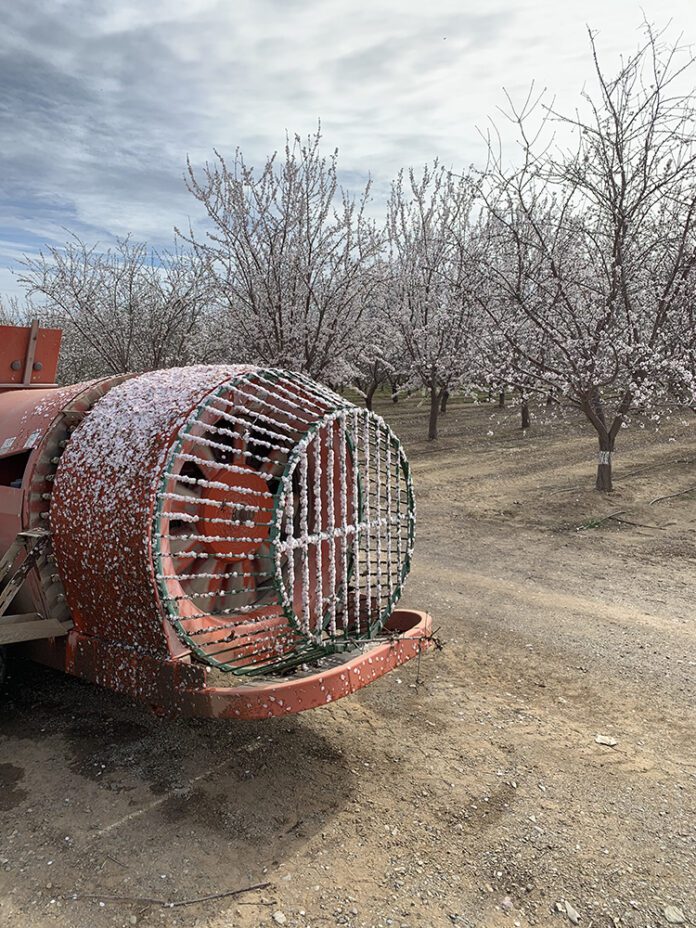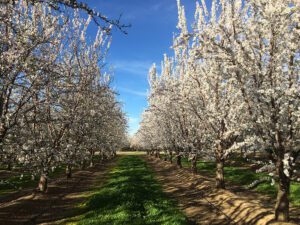
Well, here we go into the 2024 almond growing season. With soft pricing (from what I’ve heard) along with other economic challenges (interest rates, rising costs, etc.), this very well could be another tough year for many growers and/or operations. Careful focus on the key issues of orchard production will give growers and their advising PCAs and CCAs the best shot at a decent to good year. Since growers can’t control market price, producing a large, quality crop seems to be the best way forward. The goal is the most efficient production of a large, quality crop that delivers the best net return to growers. Maximum net returns, not maximum production, is the goal.
Weather for the late winter and early spring is forecast to be warmer and wetter than average up and down the Central Valley. That should be good news for reservoirs, surface water allocations and irrigation water quality in many parts of the state. But, if it’s a wet and warm late winter/early spring, disease risk for nut growers will be up, especially almond growers given almond bloom timing. We’ll see how the weather turns out (the forecast I read was written in late December 2023), but it’s a good idea to be prepared. With any luck, the warmer weather forecast will mean a lack of cold temperatures that hit the Sacramento Valley growers particularly hard in 2022 and again in 2023.
Irrigation
Contact a mobile water lab (see contact info in the credits) to inspect your irrigation systems and direct attention to areas of the system that need to be maintained. This helps both water and nutrient distribution in the orchard.
Frost
Irrigation water should go on when the wet-bulb, not ambient air temperature, reaches the critical temperature. If the air is dry (low dew point), turning on the sprinklers can result in evaporation of irrigation water and further cooling of the orchard. When this happens, the wet-bulb temperature is the limit to evaporative cooling, and this why it’s so important to start sprinklers before the wet-bulb temperature reaches the critical point where freeze damage occurs. If frost is in the forecast, the warmest orchards will be those with short vegetation (no more than 2” tall) with moist and dark top soil (top 12” of soil) that will absorb heat from the sun during the day and release it at night. If the cold snap extends for several days and the soil surface dries and lightens in color, it’s a good idea to give a short shot of irrigation water to rewet the top 12” of soil. Frost can also lead to bacterial blast damage, most importantly at bloom.
Bees
Rent bees not boxes. If it’s a wet bloom, as forecast, the difference between a poor or good crop could be one afternoon of good bee activity. Hive strength is key to that activity. Stronger hives are more active and fly at slightly cooler temperatures. A 12-frame hive collects more pollen (visits more flowers) than three four-frame hives. If hive strength (for example, average number of frames of bees per hive) is not stipulated in the pollination contract, the grower can’t be certain of the needed bee activity during bloom. This could hurt nut set and overall yield.
Growers and beekeepers should also communicate regarding hive placement and practices to support bee health. Under good conditions, placing bees farther than a quarter of a mile apart risks reducing nut set and crop yield in areas furthest from hives. Hives should be placed in sunny locations so the hives warm quickly as the sun rises, encouraging earlier foraging. Hives should not be directly sprayed by any application (fungicide, herbicide, etc.) and, wherever possible, fungicide spraying should be delayed until later in the afternoon when pollen has been stripped from the flowers so spray doesn’t move to the hive with pollen. At bloom, the only products in the spray tank should be fungicides. Adjuvants, insecticides and/or nutrients in a bloom spray risk harming bees and hive health. Maintaining the best possible bee/hive health is needed for a successful crop, especially with the expected weather this year.
Pests
By now, sanitation shaking and poling should be finished or almost finished. However, worms can survive in mummies on the orchard floor, so the job isn’t done until mummies are destroyed. The downed mummy nuts should be windrowed and shredded by March 1. Many growers gather and shred mummies as part of frost protection programs (the warmest orchards are those with orchard floor vegetation 2” tall or less.)
Blowing/windrowing downed nuts ahead of frost protection mowing gets mummy destruction in the bargain if the mowers move slow enough to destroy all nuts in the row. Also, missing or worn flail knives risk missing some mummies. Specialized, heavy-duty mowers designed for sanitation/mummy destruction are commercially available from Rears and Vrismo.
A forecast of warm, wet weather could mean a very tough bloom disease period. Under those conditions, UC recommends two fungicide sprays, one at pink bud and one at full bloom. Not all fungicides effectively control all diseases at bloom. While brown rot is always a concern, anthracnose can infect flowers if bloom is warm, while cooler temperatures and moisture promote the diseases that contribute to jacket rot. While two bloom sprays are best during wet bloom, experienced advisors tell me that one good bloom spray should avoid severe disease infection if the proper materials, rates and application practices are followed. This is not a recommendation but offered as a justification of applying one solid spray instead of skipping bloom sprays due to budget limits.
With a wet bloom in the forecast and tight economics, the temptation to trim costs could contribute to increased risk of fungicide resistance. Here’s a quick review of the UC guidelines for fungicide resistance management (“Rules”). Rotate chemistries; Use labeled rates; Limit the use of single-site chemistries to one to two times/year; Educate yourself about fungicides and their use; and Start strong with a multi-site, pre-mix or tank-mix fungicide(s) in the first spray of a program to reduce the fungal population as the season begins (same general concept as orchard sanitation).
Finally, how and when a spray goes on impacts the results. The best fungicide selection, use rate and spray timing won’t deliver the control you pay for and expect if a good spray job is not done. Sprayers should be calibrated to deliver uniform coverage throughout the canopy. If it’s too wet to get into the orchard, a properly timed (ahead of rain) aerial application beats an after-the-storm spray by ground rig. Once half the flowers are open, slowing spray movement in the canopy, every-other-row spraying delivers every-other-row disease control. Spray every row to get the best control.
In a wet spring, phytophthora infections (root and crown rot plus aerial phytophthora) can impact orchard health. While protection practices aren’t effective until March when the canopy begins to fill, allowing foliar spray uptake or xylem flow for mobile materials, it’s good to put on the calendar to discuss with your PCA (or growers).

Bacterial blast can damage flowers if cold temperatures occur at bloom. If a Section 18 is approved for Kasumin®, that material is the best management tool available, providing good control for a week or so. Copper resistance is widespread in the pest bacteria (Pseudomonas syringae) population, so use of a copper-containing product for blast control can give false hope and probably little else. Adding mancozeb to copper may help overcome the copper resistance but be careful due to copper phytotoxicity. Applications of biologicals, such as Botector®, Actinovate®, etc., at four, three two and one week from frost can provide some protection to flowers although not labeled for blast control/protection. Frost protection should reduce blast damage as frost encourages bacterial infection.
Considering weed control in a tight budget year, Dr. Brad Hanson, UCCE weed specialist, recommends several approaches. I’m paraphrasing here: 1) If you are going to cut weed management, young orchards are the last place to do it. Weeds compete for water and nutrients as well as interfere with irrigation (microsprinkler coverage) when steady growth is the goal for young orchards. Weedy tree rows in young orchards also provide cover for voles (meadow mice). Voles can kill young trees by girdling the trunks just below ground level. Weed-free tree rows let predators (hawks and owls) see voles and so help control this rodent pest. 2) Scout the orchard to find out the weeds present and consider where/how those weeds strongly impact the orchard and operations. For example, are there weeds that interfere with sprinkler irrigation coverage? If so, kill the weeds before they get tall enough to deflect water stream and before seeds develop. Early control can reduce/eliminate the cost of hand crews to remove dead weeds interfering with water and nutrient distribution plus reduce seed numbers for next year. 3) Shorten/narrow weed strips but allow for a single mower pass. The tree rows are the critical area to protect from weed competition. 4) Lower your standards a little for how clean the orchard should look if weed competition is managed and interference with irrigation and harvest is acceptable.
Nutrition
Other than an early (pink bud stage) boron foliar fertilizer, no nutrients are needed at this time of year. An early bloom boron spray is an option if a fall boron spray was not applied. Increases of 100 to 300 pounds of crop/acre from a single spray of 2 lbs Solubor/acre (0.4 lb actual boron/acre) are documented when hull levels are low to adequate and irrigation and fertility supplied to grow the additional crop. Boron spray timing is tricky at bloom. Boron applied at pink bud increases fruit set while the same spray at full bloom reduces fruit set (fall boron spraying avoids these issues.)
What about other nut crops? Walnuts and pistachio are dormant in February, allowing orchard sanitation for navel orangeworm and certain disease (in pistachios) to continue until bud swell.
It is also a good time to monitor walnuts for scale (walnut, San Jose, Italian pear and/or frosted scale) to determine if a delayed dormant treatment is needed. Scale control is part of Botryosphaeria management.
It’s too early to tell how the season will shape up, but here’s hoping for full reservoirs and better prices as the season gets rolling.
Resources
Climate forecast: cpc.ncep.noaa.gov/
Mobile irrigation labs:
tehamacountyrcd.org/mobile-irrigation-lab
sutterrcd.specialdistrict.org/mobile-irrigation-lab-367e01c
yolorcd.org/what-we-do/bilingual-mobile-irrigation-lab/
https://www.northwestkernrcd.org/
Frost protection with table of critical temperatures: sacvalleyorchards.com/almonds/horticulture/frost-protection-2/
Beehive strength/stocking:
almondpollination.ucdavis.edu/
thealmonddoctor.com/honeybee_hives_for_almond_orchards/
scientificbeekeeping.com/determining-the-relative-value-of-hives-for-almond-pollination/
Fungicide Timing and Efficacy: ipm.ucanr.edu/agriculture/ (scroll to the page bottom to see the link to the free pub.)
Weed ID: ipm.ucanr.edu/agriculture/almond/Weed-Photo-Gallery-with-common-and-scientific-names/
Monitoring for scale in walnuts:
ipm.ucanr.edu/agriculture/walnut/dormant-monitoring/
Dormant/delayed dormant practices in pistachio:
ipm.ucanr.edu/agriculture/pistachio/dormancy-to-delayed-dormancy/















